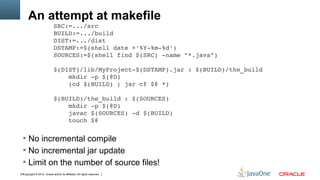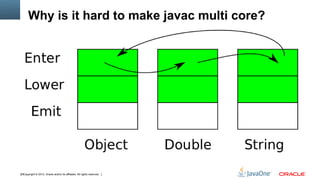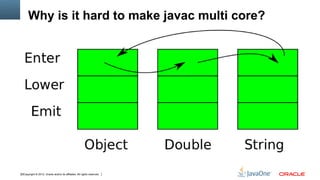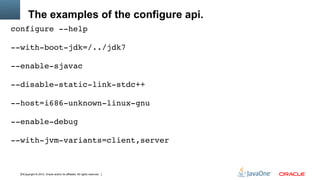Building Large Java Projects Faster: Multicore javac and Makefile integration
- 1. Copyright © 2012, Oracle and/or its affiliates. All rights reserved. Insert Information Protection Policy Classification from Slide 131
- 2. Copyright © 2012, Oracle and/or its affiliates. All rights reserved. Insert Information Protection Policy Classification from Slide 132 Building Large Java Projects Faster: Multicore javac and Makefile integration Fredrik Öhrström Principal Engineer & Patent Liaison
- 3. Copyright © 2012, Oracle and/or its affiliates. All rights reserved.3 The following is intended to outline our general product direction. It is intended for information purposes only, and may not be incorporated into any contract. It is not a commitment to deliver any material, code, or functionality, and should not be relied upon in making purchasing decisions. The development, release, and timing of any features or functionality described for Oracle’s products remains at the sole discretion of Oracle.
- 4. Copyright © 2012, Oracle and/or its affiliates. All rights reserved.4 What is the output from javac? From a single Java source file, javac can generate: Zero, to an infinite number of classes with unpredictable file names. (package-info.java, inner classes and package private classes not matching the file name) If annotation processors are in use, then anything can happen. (New sources, new packages, new xml-files, png-files etc)
- 5. Copyright © 2012, Oracle and/or its affiliates. All rights reserved.5 How javac (re)compiles code Javac requires explicit source files on the command line (or @file) The explicit sources are always compiled and linking dependencies outside the explicit sources, are read from the classpath. (eg java.lang.Object, org.antlr.runtime.CharStream, etc) If the to be linked dependencies are not yet compiled, then use -sourcepath srcroot to link to source code.
- 6. Copyright © 2012, Oracle and/or its affiliates. All rights reserved.6 How javac (re)compiles code Unfortunately, the default behavior for to be linked sources found through the -sourcepath, is to emit classes for these sources. Unless: If -implicit:none is supplied on the command line Or the corresponding class in the (boot)classpath or -d directory is newer than the source. If you develop jaxp (which is part of the jdk), then a jdk installed after your source was written, will override your source in the sourcepath, even though your source is probably newer.
- 7. Copyright © 2012, Oracle and/or its affiliates. All rights reserved.7 Compiling, Headers and Linking in the Java world. At runtime, linking of imports is done lazily when the class is loaded. At compile time, usage of imports are checked against the class files in the (boot)classpath. At compile time, usage of imports are checked against the source files in the sourcepath or explicit sources to be compiled. But these checks will trigger a full compile of the referenced classes. Not only their public apis. This makes it very easy to create circular dependencies.
- 8. Copyright © 2012, Oracle and/or its affiliates. All rights reserved.8 How javac (re)compiles code Implicit generation of classes and accidentally not recompiling your own source code, is usually not a problem. Because most developers do not develop code that resides in the jdk. But implicitly generated classes contribute to the confusion of what javac outputs!
- 9. Copyright © 2012, Oracle and/or its affiliates. All rights reserved.9 How a makefile works imperative statements goal: requirements action that generates goal # A makefile is executed imperatively to create # a dependency tree from goals to requirements
- 10. Copyright © 2012, Oracle and/or its affiliates. All rights reserved.10 How a makefile works FLAGS += Os app: app.c app.h gcc $(FLAGS) o $@ $< # Then a sequence of actions are calculated # to generate the goal given on the command line. # A goal with a newer timestamp than its # requirements is considered up to date.
- 11. Copyright © 2012, Oracle and/or its affiliates. All rights reserved.11 How a makefile works, macro calls $(eval $(call SetupJavaCompilation,BUILD_JAXP, SETUP:=GENERATE_NEWBYTECODE, SRC:=jaxp/src, BIN:=output/classes, SRCZIP:=output/src.zip), JAR:=output/classes.jar)) all: output/src.zip output/classes.jar
- 12. Copyright © 2012, Oracle and/or its affiliates. All rights reserved.12 A javac command line javac bootclasspath classes d classes src/java/lang/Object.java src/java/lang/CharacterData.java src/java/lang/OutOfMemoryError.java src/java/lang/Character.java src/java/lang/Override.java src/java/lang/CharacterName.java src/java/lang/packageinfo.java src/java/lang/CharSequence.java src/java/lang/Package.java src/java/lang/ClassCastException.java src/java/lang/ProcessBuilder.java src/java/lang/ClassCircularityError.java src/java/lang/Process.java src/java/lang/ClassFormatError.java src/java/lang/Readable.java src/java/lang/Class.java src/java/lang/ClassLoader.java src/java/lang/ClassNotFoundException.java src/java/lang/ReflectiveOperationException.java src/java/lang/ClassValue.java src/java/lang/Runnable.java src/java/lang/Cloneable.java ..... and ca 8000 more files.... You cannot really use the command line for large projects. An @-file can be used to work around the command line length problem. We need to use an external tool.
- 13. Copyright © 2012, Oracle and/or its affiliates. All rights reserved.13 An ant build file <project name="MyProject" default="dist" basedir="."> <property name="src" location="src"/> <property name="build" location="build"/> <property name="dist" location="dist"/> <target name="init"> <tstamp/> <mkdir dir="${build}"/> </target> <target name="compile" depends="init" description="compile it> <javac srcdir="${src}" destdir="${build}"/> </target> <target name="dist" depends="compile" description=”generate jar”> <mkdir dir="${dist}/lib"/> <jar jarfile="${dist}/lib/MyProject${DSTAMP}.jar" basedir="${build}"/> </target> </project>
- 14. Copyright © 2012, Oracle and/or its affiliates. All rights reserved.14 An attempt at makefile SRC:=.../src BUILD:=.../build DIST:=.../dist DSTAMP:=$(shell date +'%Y%m%d') SOURCES:=$(shell find $(SRC) name ”*.java”) $(DIST)/lib/MyProject$(DSTAMP).jar : $(BUILD)/the_build mkdir p $(@D) (cd $(BUILD) ; jar cf $@ *) $(BUILD)/the_build : $(SOURCES) mkdir p $(@D) javac $(SOURCES) d $(BUILD) touch $@ No incremental compile No incremental jar update Limit on the number of source files!
- 15. Copyright © 2012, Oracle and/or its affiliates. All rights reserved.15 The major obstacles to writing makefiles for Java unpredictable output from javac for any decent size Java project, the filenames of the Java sources do not fit on the command line!
- 16. Copyright © 2012, Oracle and/or its affiliates. All rights reserved.16 Whither ant? Whither make? It does not matter if you prefer make or ant. You cannot do proper dependency tracking and incremental builds in Java because: Javac lacks the necessary features! This cannot be fixed, lest you write your own Java compiler, which is a lot of work. It does not matter if you prefer make or ant. You cannot get proper multi core support for speeding up compilation times for large Java projects, because: Javac lacks the necessary features! This cannot be fixed externally.
- 17. Copyright © 2012, Oracle and/or its affiliates. All rights reserved.17 Whither ant? Whither make? But what about ant depend? Limited to what it can see in class files, eg cannot see where final statics came from. But what about ant fork=yes? Does not work within a single javac task. Manual splitting of sources is needed.
- 18. Copyright © 2012, Oracle and/or its affiliates. All rights reserved.18 Whither IDEs? IDEs like Eclipse and Netbeans do keep a database of the source dependencies in memory. Needed for quick and efficient incremental compiles while editing! But very limited support for multi core compiles. We need ant/make for batch compiles on build servers anyway.
- 19. Copyright © 2012, Oracle and/or its affiliates. All rights reserved.19 A first attempt at improving javac added a server to javac added -XDdepfile=...... added -XDnativeapifile=..... added -XDpubapifile=.... Relied on make (sic!) to split compile into multiple cores with a javac invocation for each package. This worked, sort of, but lets look at the makefile.
- 20. Copyright © 2012, Oracle and/or its affiliates. All rights reserved.20 A horribly complex (tiny) part of a makefile $2 : $$($2_PACKAGE_SRCS) $(MKDIR) p $$($2_PACKAGE_BDIR) $(RM) $2.tmp $$(call ListPathsSafely,$2_PACKAGE_SRCS,n, >> $2.tmp) $(ECHO) $$($2_PACKAGE_BDIR)*.class | $(GREP) v *.class | $(TR) ' ' 'n' > $$($2_PACKAGE_BDIR)_the.package.prev $(RM) $$($2_PACKAGE_BDIR)*.class $$($2_PACKAGE_BDIR)*.notify $$($2_PACKAGE_BDIR)*.deleted $(ECHO) Compiling `$(WC) $2.tmp | $(TR) s ' ' | $(CUT) f 2 d ' '` files in package $(patsubst $4/%/,%, $(dir $2.tmp)) $9 $$($2_REMOTE) $$($2_DEPS) $$($2_PUBAPI) $$($2_NATIVEAPI) $(10) implicit:none sourcepath "$$($2_SRCROOTSC)" d $4 @$2.tmp $(ECHO) $$($2_PACKAGE_BDIR)*.class | $(GREP) v *.class | $(TR) ' ' 'n' > $$($2_PACKAGE_BDIR)_the.package.now ($(GREP) xvf $$($2_PACKAGE_BDIR)_the.package.now $$($2_PACKAGE_BDIR)_the.package.prev > $$($2_PACKAGE_BDIR)_the.package.deleted;true) $(ECHO) $1_CLASSES += `$(CAT) $$($2_PACKAGE_BDIR)_the.package.now` | $(SED) 's/$$$$/$$$$$$$$/g' > $$($2_PACKAGE_BDIR)_the.package.d $(ECHO) $1_JAVAS += $$($2_PACKAGE_SRCS) >> $$($2_PACKAGE_BDIR)_the.package.d $(ECHO) $2_NOTIFIED:=true > $$($2_PACKAGE_BDIR)_the.package.notify $$($2_APPEND_DEPS) $$($2_COPY_FILES) $(MV) f $2.tmp $2
- 21. Copyright © 2012, Oracle and/or its affiliates. All rights reserved.21 A better way, move the makefile logic into a smart javac wrapper (sjavac) written in Java. sjavac -src sources -d classes Compiles all sources below sources. (Expects standard package file structure) Creates a classes/javac_state file that contains the necessary information for incremental compiles. (timestamps, artifacts, dependencies and public apis) Forces -implicit:none Supports multiple cores. javac must provide hooks for this wrapper to work.
- 22. Copyright © 2012, Oracle and/or its affiliates. All rights reserved.22 A much better part of a makefile (plain javac) (common/makefiles/JavaCompilation.gmk) $$($1_BIN)/_the.batch: $$($1_SRCS) $$($1_DEPENDS) $(MKDIR) p $$(@D) $$(call ListPathsSafely,$1_SRCS,n, >> $$($1_BIN)/_the.batch.tmp) $(ECHO) Compiling $1 $$($1_JVM) $$($1_JAVAC) @$$($1_BIN)/_the.batch.tmp $$($1_FLAGS) d $$($1_BIN) $$($1_HEADER_ARGS) Apropos the ListPathsSafely macro.... my birthday present wish is a new function in GNU make: $(write_to_file the.batch.tmp $(SOURCES)) Such a function can be used to solve any command line length limitation!
- 23. Copyright © 2012, Oracle and/or its affiliates. All rights reserved.23 A much better part of a makefile (sjavac) (common/makefiles/JavaCompilation.gmk) $$($1_BIN)/javac_state: $$($1_SRCS) $$($1_DEPENDS) $(MKDIR) p $$(@D) $$(call ListPathsSafely,$1_SRCS,n, >> $$($1_BIN)/_the.batch.tmp) $(ECHO) Compiling $1 $$($1_JVM) $$($1_SJAVAC) $$($1_REMOTE) $$($1_SJAVAC_ARGS) permitunidentifiedartifacts mfl $$($1_BIN)/_the.batch.tmp $$($1_FLAGS) d $$($1_BIN) $$($1_HEADERS_ARG) Apropos the ListPathsSafely macro.... my birthday present wish is a new function in GNU make: $(write_to_file the.batch.tmp $(SOURCES)) Such a function can be used to solve any command line length limitation!
- 24. Copyright © 2012, Oracle and/or its affiliates. All rights reserved.24 Your future makefile SJAVAC:=java jar javac.jar com.sun.tools.sjavac.Main SOURCES:=$(shell find src name ”*.java”) bin/javac_state : $(SOURCES) $(SJAVAC) src src h jniheaders d bin Very fast source file timestamp scan, courtesy make Proper incremental build, including removal of class files. Proper generation and removal of C-header files for JNI Multi core support Oops, jar is not incremental....yet.
- 25. Copyright © 2012, Oracle and/or its affiliates. All rights reserved.25 Your future ant build.xml just replace the task javac with sjavac Not so fast source file timestamp scan, but ok.
- 26. Copyright © 2012, Oracle and/or its affiliates. All rights reserved.26 Your future ant build.xml R src src d bin P com.sun.java_cup.internal.runtime S src/com/sun/java_cup/internal/runtime/Scanner.java 1347955522000 D java.lang D java.util I TYPE com.sun.java_cup.internal.runtime.Scanner I METHOD public abstract com.sun.java_cup.internal.runtime.Symbol next_token( ) throws java.lang.Exception I VAR public int sym A bin/com/sun/java_cup/internal/runtime/Scanner.class 1349217684000
- 27. Copyright © 2012, Oracle and/or its affiliates. All rights reserved.27 Why is it hard to make javac multi core?
- 28. Copyright © 2012, Oracle and/or its affiliates. All rights reserved.28 Why is it hard to make javac multi core?
- 29. Copyright © 2012, Oracle and/or its affiliates. All rights reserved.29 Why is it hard to make javac multi core?
- 30. Copyright © 2012, Oracle and/or its affiliates. All rights reserved.30 Why is it hard to make javac multi core?
- 31. Copyright © 2012, Oracle and/or its affiliates. All rights reserved.31 One way to do it.....
- 32. Copyright © 2012, Oracle and/or its affiliates. All rights reserved.32 Optimistic splitting compiling 3 cores give a 20% speedup. Object.java is always compiled thrice.... Obvious improvements: Share already compiled classes Share loaded classes from classpath Do emit on all cores
- 33. Copyright © 2012, Oracle and/or its affiliates. All rights reserved.33 Optimistic splitting compiling Need a new warning -Xlint:auxiliaryclass Catches references to classes hidden inside sourcefiles in such a way that they cannot be found on the through the -sourcepath. Since this breaks multi core compilation (and is generally a nuisance).
- 34. Copyright © 2012, Oracle and/or its affiliates. All rights reserved.34 Lets investigate the new build system for the OpenJDK Which was in fact the cause for developing sjavac
- 35. Copyright © 2012, Oracle and/or its affiliates. All rights reserved.35 Status quo april 2011 Too speed up the OpenJDK build we faced a formidable problem! Javac quirks and limitations The Java language tendency for circular dependencies Undocumented side effects of compiles No working dependency propagation Java --> C++ --> Java Lack of proper dependency propagation makes it hard to parallelize the build! Of course all the above are relevant for incremental builds too!
- 36. Copyright © 2012, Oracle and/or its affiliates. All rights reserved.36 The OpenJDK is a complex product It has a Java compiler It has a JVM containing C++ code and Java code. It has the JDK, containing C/C++ code and Java code. It has complex intra-dependencies: C++ code depends on C-headers generated from Java code. Java code generated from C-headers from the OS. Generated Java/C and C++ code from several different sources. The new Java code sometimes needs the new Java compiler The new Java compiler sometimes needs the new JDK
- 37. Copyright © 2012, Oracle and/or its affiliates. All rights reserved.37 The Old OpenJDK build system was troublesome Controlled through environment variables and command line variables No working dependency tracking Slow compilation because of inefficient usage of build computer Multiple almost identical copies of the same Makefiles The source code has platform specific files in share/classes and vice versa A huge technical debt
- 38. Copyright © 2012, Oracle and/or its affiliates. All rights reserved.38 The Old OpenJDK build system was troublesome Each and every developer created their own build setup script. This knowledge was shared through a human peer to peer network. We encoded this knowledge into a configure script. The configure api is a well known standard.
- 39. Copyright © 2012, Oracle and/or its affiliates. All rights reserved.39 How to configure and build using the new build system. hg clone http://hg.openjdk.java.net/buildinfra/jdk8 cd jdk8 sh get_source.sh cd common/makefiles bash ../autoconf/configure –enablesjavac make ...........a lot of output........ cd ../.. ./build/linuxx86normalserverrelease/jdk/bin/java version make images ls ./build/linuxx86normalserverrelease/images/j2sdkimage make install
- 40. Copyright © 2012, Oracle and/or its affiliates. All rights reserved.40 Contents of the generated spec.gmk file. SRC_ROOT:=/work/jdk8 ... OUTPUT_ROOT:=/work/jdk8/build/linuxx86normalserverrelease ... BOOT_JDK:=/usr/lib/jvm/java7openjdki386 ... CC:=CCACHE_COMPRESS=1 CCACHE_SLOPPINESS=time_macros /usr/local/bin/ccache /usr/bin/cc ... USE_EXTERNAL_LIBJPEG:=true USE_EXTERNAL_LIBGIF:=false USE_EXTERNAL_LIBZ:=false ... SYS_ROOT:=/
- 41. Copyright © 2012, Oracle and/or its affiliates. All rights reserved.41 The examples of the configure api. configure help withbootjdk=/../jdk7 enablesjavac disablestaticlinkstdc++ host=i686unknownlinuxgnu enabledebug withjvmvariants=client,server
- 42. Copyright © 2012, Oracle and/or its affiliates. All rights reserved.42 The first build of the OpenJDK with the new build system and multi core sjavac .... ... . Compiling 2985 files in 181 packages (com.oracle.net to java.util.concurrent) Compiling 2973 files in 168 packages (java.util.concurrent.atomic to sun.nio.ch.sctp) Compiling 3022 files in 559 packages (sun.nio.cs to sun.util.xml) .... ... . Use “make VERBOSE=” to see all command lines.
- 43. Copyright © 2012, Oracle and/or its affiliates. All rights reserved.43 The actual command line to compile the JDK! sjavac –server:portfile=javacservers/server.port,poolsize=8, id=GENERATE_JDKBYTECODE,javac=sjavac x com.sun.pept.* x com.sun.tools.example.trace.* xf *SolarisFileStore.java xf *SolarisFileSystem.java ... many more filter rules ............... src jdk/src/share/classes:jdk/src/solaris/classes:gensrc permitunidentifiedartifacts mfl ...._the.batch.tmp bootclasspath jdk/classes source 7 target 7 encoding ascii XDignore.symbol.file=true Xlint:all,....,auxiliaryclasses implicit:none d jdk/classes h jdk/gensrc_headers
- 44. Copyright © 2012, Oracle and/or its affiliates. All rights reserved.44 An incremental build of the OpenJDK touch ../../jdk/src/share/classes/com/sun/tools/jdi/SDE.java make ######################################################################## ######################################################################## ##### Entering jdk for target(s) all ##### ######################################################################## Compiling BUILD_JDK Compiling com.sun.tools.jdi(80) Note: /home/fohrstro/jdk8/jdk/src/share/classes/com/sun/tools/jdi/EventRequestMa nagerImpl.java uses unchecked or unsafe operations. Note: Recompile with Xlint:unchecked for details. ######################################################################## ##### Leaving jdk for target(s) all ##### ######################################################################## ##### Build time 00:00:08 jdk for target(s) all ##### ########################################################################
- 45. Copyright © 2012, Oracle and/or its affiliates. All rights reserved.45 An incremental build of the OpenJDK emacs nw ../../jdk/src/share/classes/javax/net/SocketFactory.java make ... .. . Compiling javax.net(2) Package javax.net pubapi has changed! Compiling com.sun.jndi.ldap(46) Compiling javax.net.ssl(37) javax.rmi.ssl(2) ... .. .
- 46. Copyright © 2012, Oracle and/or its affiliates. All rights reserved.46 Old New +sjavac no ccache New no sjavac primed ccache New +sjavac empty ccache New +sjavac primed ccache Langtools 37s 30s 29s 31s 31s Corba 1m32s 7s 16s 7s 7s Jaxp 18s 7s 15s 7s 7s Jaxws 23s 9s 19s 9s 9s Hotspot 3m01s 3m05s 1m10s 5m18s 1m7s Jdk 9m52s 1m23s 2m9s 1m25s 50s Total 15m43s 5m21s 4m38s 7m37s 2m51s OpenJDK Build times: GNU/Linux 64bit 8cores 16GB sjavac doubles the compilation speed! This is due to the server and multi core support. There are several opportunities for improving the multi core support! We have only skimmed the surface so far.
- 47. Copyright © 2012, Oracle and/or its affiliates. All rights reserved.47 Summary Initial support for multi core javac, more to come. Incremental Java builds from the command line with proper dependency tracking. The new javac -h option to generate C-headers for JNI A new lint warning -Xlint:auxiliaryclass A much more inviting development environment for every new developer who wants to contribute to the OpenJDK!
- 48. Copyright © 2012, Oracle and/or its affiliates. All rights reserved.48 TODO Push into tl/jdk8/langtools now it is inside build-infra/jdk8/langtools Incremental jar updates Write sjavac task for ant Add public api tracking for classes and jars
- 49. Copyright © 2012, Oracle and/or its affiliates. All rights reserved. Insert Information Protection Policy Classification from Slide 1349

















































